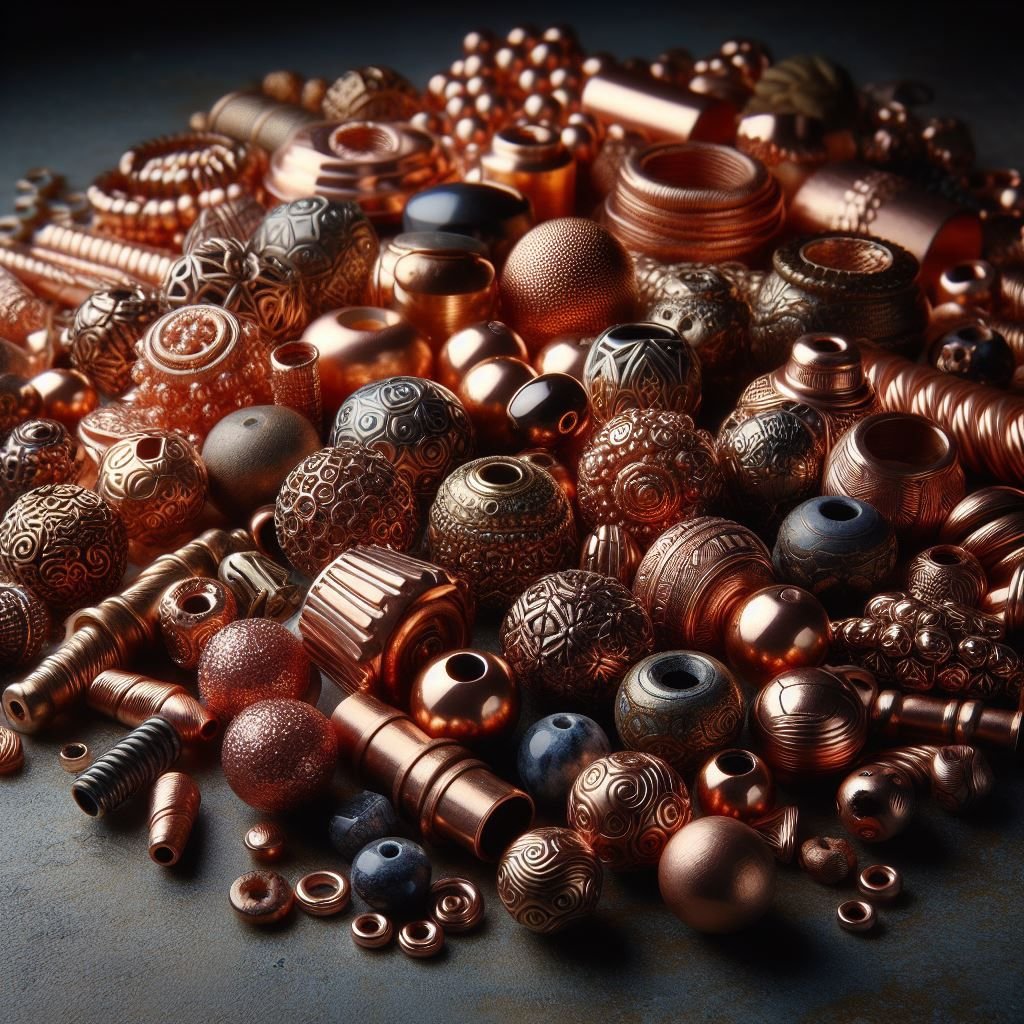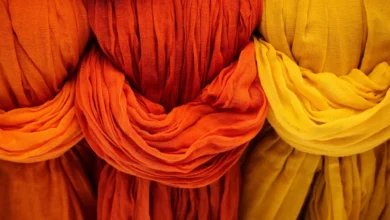
Copper adds a touch of warmth and rustic charm to any handmade jewelry or craft project. Its beautiful natural patina and versatility make it a favorite among artisans. However, with so many options on the market, choosing authentic, high-quality copper beads can be tricky. Here’s a guide to help you find the perfect beads for your creations.
Identifying Real Copper Beads
Color
Real copper beads and findings have a distinctive reddish-orange hue. If a bead is overly shiny or yellow, it’s likely plated or an alloy.
The Red-Orange Glow: Describe pure copper’s warm, reddish-orange tone, perhaps comparing it to the color of a sunset or a penny. Emphasize how this differs from brighter, yellow tones.
Plating vs. Solid: Explain that copper-plated beads have a thin copper layer over a different metal, making them look less vibrant or artificially shiny. Alloys of copper, like brass, are yellower in color.
Signs of Wear: Mention how plated beads may show signs of their base metal (often silvery) through scratches or areas where the plating has worn thin.
Magnet Test
Copper is non-magnetic. A strong magnet shouldn’t be attracted to it.
Why it Matters: Explain the concept of magnetism, noting that iron and many other common metals are magnetic. Copper’s non-magnetic property helps distinguish it.
Using a Strong Magnet: I recommend using a powerful neodymium magnet for the best results with this test.
The Exception: Some copper may be very slightly magnetic due to impurities. However, a strong magnet shouldn’t stick to it as it would to a piece of iron.
Patina
Over time, pure copper reacts with the environment, developing a greenish-blue patina. This is a mark of authenticity.
The Science of Change: Briefly describe how oxygen and moisture in the air interact with copper to form the patina (copper oxide).
Not Dirt or Rust: Stress that the patina is not a flaw but a natural transformation that protects the copper beneath.
The Range of Colors: The patina can range from subtle turquoise to deep green-blue shades, depending on the environment.
Price
Real copper will generally be more expensive than plated alternatives.
Material Costs: Explain that copper is a more expensive raw material than the base metals used in plated jewelry.
Production Differences: Note that solid copper beads may require more labor-intensive methods than simple plating.
Value vs. Cost: Suggest that the initial cost of real copper is an investment that pays off through durability and the development of that beautiful patina over time.
Also, read more: Winning Designs and Projects Using Sterling Silver Sports Charms
Types of Real Copper Beads
Solid Copper Beads
These are the purest and most durable form of copper beads. They offer the most potential for developing a beautiful patina.
Unmatched Authenticity: Emphasize that solid copper beads are made entirely of copper, through and through. This ensures maximum exposure to the natural elements, leading to the most authentic and complex patina development over time.
Long-lasting Investment: Highlight the durability of solid copper. Because there’s no core of a different metal, there’s no danger of plating chipping or wearing away, revealing the base material. Solid copper will remain beautiful for generations.
Variation within Purity: Mention that even solid copper beads can have slight variations in purity (for example, 99.9% pure copper). This will subtly impact the rate of patina development but shouldn’t be a major concern.
Copper-Plated Beads
A more affordable option, these have a base metal core with a layer of copper on the surface. Be aware that the plating can wear off with time.
The Benefit of Cost: Acknowledge the primary advantage of copper-plated beads – their lower price point compared to solid copper. This makes them accessible for large-scale projects or experimentation.
Understanding the Limitations: Be transparent about the potential for wear, particularly in areas with high friction like clasps and connecting loops. Explain that where the plating wears away, the base metal’s color (often silvery) will become visible, affecting the overall look of the jewelry.
Plating Thickness: Point out that the lifespan of copper-plated beads depends on the thickness of the plating, which can vary between manufacturers.
Copper-Filled Beads
These are similar to copper-plated but generally have a thicker copper layer, making them slightly more durable.
Middle Ground: Position copper-filled beads as a compromise between solid copper and plated. They offer enhanced durability over plated beads without the higher cost of solid copper.
The Question of Thickness: Explain that while ‘copper-filled’ implies a specific standard, there’s no regulated percentage. Some pieces might have a very thick copper layer, while others only a slightly thicker one than plated varieties. Emphasize the importance of researching the supplier.
Patina Potential: While copper-filled can still develop some patina, it may not be as dramatic or uniform as solid copper due to the presence of a different metal at the core.
Also, read more: Bead Charm Bracelets: The Friendliest Crafting Projects for Everyone
Where to Buy Real Copper Beads
Online Jewelry Supplies Stores
Online jewelry supplies stores offer the benefit of global shipping and many of them are reliable when it comes to quality.
Convenience and Accessibility: Underscore the ability to shop from anywhere, anytime with online stores. This is especially valuable if you don’t have local bead stores nearby.
Focus on Materials: Jewelry supply stores tend to have a vast selection of beads and findings, letting you source everything for your project in one place.
Confidence in Consistency: Reputable stores prioritize quality control, ensuring beads are accurately described and consistent, especially important for multi-bead projects.
Online Marketplaces
Etsy, Amazon, and similar platforms offer a vast selection of copper beads at varying prices. Look for sellers with high ratings and positive reviews.
Unmatched Variety: Marketplaces offer an almost overwhelming range of choices for any budget or style – perfect for browsing and discovery.
Competitive Pricing: The marketplace model encourages competition, meaning you can often find great deals.
Vetting is Key: Emphasize the importance of reading reviews and checking seller ratings. These platforms often have a mix of highly-rated, reliable sellers and newer/less-reviewed ones.
Bead Stores
Specialty bead shops are excellent for finding unique and high-quality copper beads. You’ll often be able to examine the beads before purchasing.
In-Person Advantage: Stress the value of seeing and touching beads in person to judge color, finish, and weight more accurately than photos allow.
Staff Expertise: Bead store employees are usually passionate and knowledgeable, providing guidance on techniques and helping you find the perfect beads.
Support Local: Bead stores are often small businesses, allowing you to support your community.
Craft Fairs and Shows
Local craft events can be treasure troves for sourcing beautiful copper beads directly from artisans.
Unique Finds: Craft shows showcase handcrafted beads with a distinctive personal touch, ideal if you want one-of-a-kind elements for your work.
Meet the Maker: Connect with the artists, learn about their inspiration and techniques, and build a relationship for future commissions or purchases.
Serendipity Factor: The joy of browsing craft fairs is discovering unexpected gems and surprising styles you might never have found online.
Also, read more: What is Gold-Filled? The Difference Between Gold-Filled, Gold-Plated, and Solid Gold?
Factors to Consider When Choosing Real Copper Beads
Size and Shape: Choose beads that complement your project’s design. Explore round beads, spacers, tubes, bicones, and other shapes.
Design Harmony: Consider the overall style you’re aiming for. Delicate designs call for smaller beads, while bold statements might incorporate larger or more dramatic shapes.
Functionality: Think about how the beads will function. Will they be the centerpiece, accent beads, or spacers between other elements? This will guide your size and shape choices.
Variety is Spice: Don’t be afraid to mix and match shapes! Round beads provide a classic base, while tubes, bicones, or unusual shapes add exciting visual interest.
Finish: Different hammered, polished, or antique finishes create distinct looks.
Smooth vs. Textured: Polished copper offers gleam and shine, while hammered finishes have a rustic, handcrafted feel. Antique finishes provide a more muted, aged look.
Matching Your Style: Consider your design aesthetic. Polished copper suits sleek, modern designs, while hammered might align better with a bohemian aesthetic.
Embrace the Patina: Remember, the finish can impact how the patina develops. Highly polished surfaces might have a subtler patina compared to those with texture.
Quantity: Consider the scope of your project and whether you prefer buying in bulk or smaller quantities.
Project Scale: A simple necklace might only need a few beads, while a multi-strand bracelet or intricate design could require a substantial amount.
Budgeting: Suppliers often offer discounts for bulk purchases. If you’re confident you’ll use lots of a specific bead, this can be cost-effective.
Experimentation: Smaller quantities are great if you’re trying new designs or want to incorporate various bead styles before committing.
Supplier Reputation: Buy from reputable suppliers to ensure you’re getting genuine copper beads.
Doing Your Research: Read reviews, check websites, and compare prices between suppliers. Well-established businesses are more likely to provide accurate descriptions and quality control.
Avoid “Too Good to Be True”: Be wary of extremely low prices. They can be a sign of plated or lower-quality beads.
Certification Matters: Some suppliers may offer certified copper beads, guaranteeing their purity and authenticity.
Caring for Real Copper Beads
Cleaning: To remove tarnish, use a gentle jewelry cleaner specifically formulated for copper or try a homemade solution of lemon juice and salt.
Commercial Cleaners: Emphasize that copper cleaners are specially created to remove tarnish without harming the metal. Look for brands with good reputations and positive reviews. Always follow the product’s instructions.
DIY with Caution: Explain that lemon juice and salt is a mild, natural alternative. Sprinkle salt on a cut lemon half and gently rub the bead. Be cautious – excessive rubbing or leaving the solution on too long can etch the copper.
When to Clean: Ideally, clean only when the patina becomes overly-dark or uneven. For mild tarnish, a soft polishing cloth may be all you need.
Storage: Store copper beads in airtight containers or bags to prevent oxidation.
Limiting Exposure: Explain how oxidation is accelerated by air and moisture. Airtight containers or zip-top bags create a barrier, preserving your beads’ current finish.
Anti-tarnish Materials: Mention anti-tarnish strips or paper as an optional addition to storage containers. These absorb the elements that cause patina.
Separate is Best: Advise storing copper items away from other metals to prevent discoloration from chemical reactions.
Embrace the Patina: Appreciate the natural beauty of copper patina that develops over time. It adds character and a sense of history to your creations.
The Value of Change: Emphasize that patina is not a flaw but a testament to the authenticity and dynamic nature of copper.
Unique Stories: Point out that each piece develops a patina based on environment and wear, making every copper item a one-of-a-kind.
Patience is Rewarded: Encourage acceptance of the gradual transformation of copper. While some may prefer a shiny look initially, the patina is an earned beauty that grows more complex over time.
The Aesthetics of Real Copper Beads
Copper jewelry, with its warm, earthy tones and transformative nature, holds an enduring allure that transcends time and trends. Here’s a look at the aesthetic qualities that make real copper jewelry a timeless choice:
The Warmth of the Metal
Copper’s hallmark is its unique reddish-brown hue. This warmth evokes a sense of coziness, comfort, and connection to nature. Unlike cooler-toned metals like silver or platinum, copper exudes an inviting glow that beautifully complements a wide range of skin tones and adds a touch of rustic elegance to any outfit.
The Beauty of Patina
One of the most captivating aspects of real copper jewelry is its ability to develop a patina over time. This natural process, caused by exposure to air and moisture, transforms the metal with a layer of verdigris—a beautiful blue-green coloration. This patina is unique to each piece of copper jewelry, creating a sense of history and individuality.
Versatility in Design
Copper’s malleability allows for endless design possibilities. It can be hammered, shaped, wire-wrapped, or etched, giving it tremendous versatility in jewelry making. From simple, minimalist pieces to intricately detailed, artisanal designs, copper offers a medium for a wide range of styles, making it perfectly suited for both everyday wear and statement pieces.
Symbolic and Historical Significance
Copper has been used in jewelry and adornment for millennia. Ancient civilizations prized it for its believed healing properties, spiritual significance, and association with gods and goddesses like Aphrodite and Venus. Wearing copper jewelry today carries a connection to this rich history and symbolism.
The Trend that Never Dies
While fashion trends come and go, copper jewelry remains a timeless classic. Its warmth and earthy aesthetic complement various styles, from bohemian and vintage-inspired looks to modern and minimalist designs. Copper’s versatility ensures it always finds a place in fashion, remaining a beloved choice across multiple generations.
Embracing Imperfection and Uniqueness
In a world of mass-produced jewelry, the patina and slight natural imperfections of copper give it a distinct charm. These subtle variations showcase the handmade quality and the natural beauty of the metal, making every piece one-of-a-kind.
Choosing Real Copper Jewelry
To ensure you’re investing in genuine copper jewelry, look for the characteristic reddish-brown color, test it with a magnet (it shouldn’t be attracted), and be aware that real copper is generally more expensive than plated alternatives.



